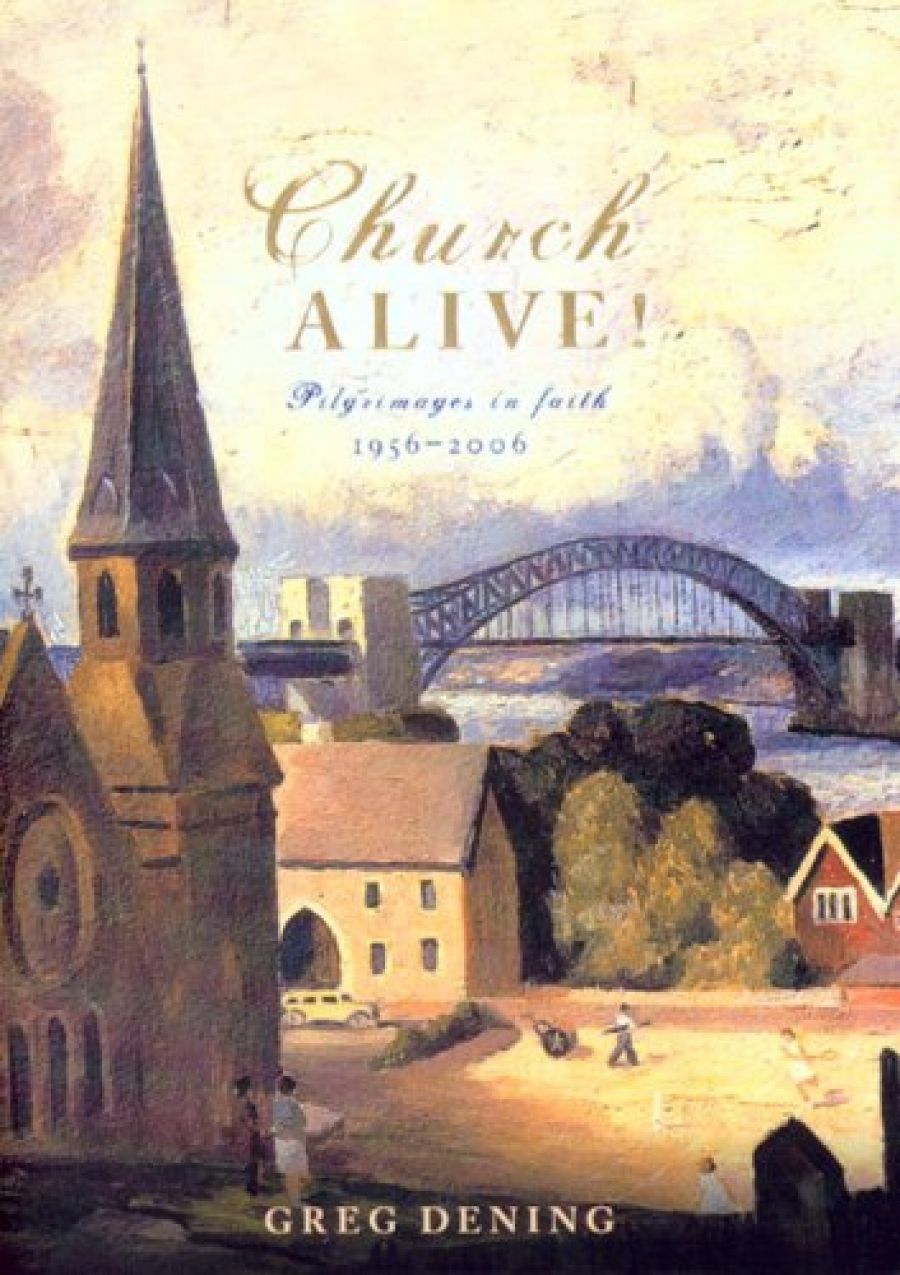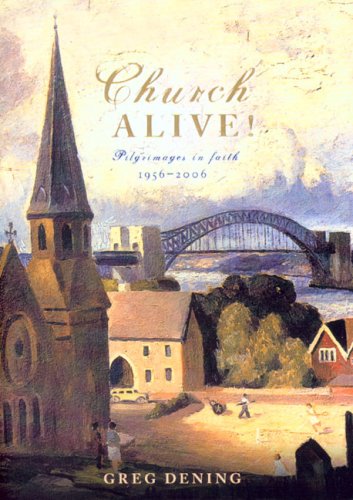
- Free Article: No
- Custom Article Title: Warming the pews
- Review Article: Yes
- Article Title: Warming the pews
- Online Only: No
- Custom Highlight Text:
There is a curious division evident in Australian politics at the moment. One side wants to talk about history, and the other wants to talk about language.
- Book 1 Title: Church Alive!
- Book 1 Subtitle: Pilgrimages in faith 1956–2006
- Book 1 Biblio: UNSW Press, $44.95 hb, 289 pp, 0868408433
- Book 1 Cover Small (400 x 600):

- Book 1 Cover (800 x 1200):

In one corner, Prime Minister John Howard has voiced concern about the standard of history teaching in Australian schools. Education Minister Julie Bishop is making further running with the issue. As far as I can tell, they seem concerned that history is being taught with too much emphasis on the past. Remember the words that haunted Winston Smith in George Orwell’s 1984: ‘he who controls the present, controls the past. He who controls the past, controls the future.’ The good news, of course, is that any genuine study of history will always defeat a narrow agenda, nationalistic or otherwise. A world in which people derive their main sense of who they are from a flag is a frightening prospect. Ironically, the study of national history may be one thing which slows down this process. History is a record of how complex we are, not how simple. A flag only ever has two dimensions.
In the other corner, a number of figures from a different side of politics have lamented the way in which politics, marketing and bureaucracy want to reduce the language to rubble. Best known of these is Don Watson, whose work on public language is a little reminiscent of Izaak Walton’s The Compleat Angler, first published in 1653, during the period of the Commonwealth. Walton’s book is the work of a political exile determined to restore savour to life, even without the trappings of power. His book is really about the fish that got away: it is recondite, delightfully odd and richly contemplative.
In books such as Death Sentence (2004) and Dictionary of Weasel Words (2005), Watson, once a speechwriter for Paul Keating, has examined the possibilities of a refreshed language from the vantage point of political exile. He is not alone. Of recent times, Michael Gurr’s fine discursive memoir, Days Like These (2006, reviewed in this issue), also considers the damage done to language when it is used to avoid communication. Gurr has been a speechwriter for Premier Steve Bracks.
This may seem like a wayward preamble for a consideration of Greg Dening’s account of the last fifty years of a Catholic parish in Sydney, but Church Alive! appears at a moment when the role of religion in Australian public life is under greater scrutiny than ever before. This is no bad thing. Innocuous terms such as ‘values’ or ‘intelligent design’ are often used to smuggle a religious agenda into politics. Religion, in my view, has much to offer the common good, but is best when it is upfront about it. In God Under Howard (2005), Marion Maddox describes an entire strategy when she comments that ‘the right’s God is most powerful just below the surface’. This God is a co-conspirator. Kevin Rudd is among those who have objected to God being turned into the tame mascot of conservatives. In the October 2006 issue of The Monthly, in a piece called ‘Faith in Politics’, Rudd reflected upon the Christian politics of theologian and pastor Dietrich Bonhoeffer, who was executed by the Nazis shortly before the end of World War II. Rudd accuses John Howard of using ‘radioactive language’ to ‘retain his incumbency at all costs’. Rudd argues the necessity of a political Christianity which ‘must always take the side of the marginalised, the vulnerable and the oppressed’.
Dening’s Church Alive! is unique because, while Christianity gets tugged this way and that on the national stage, this is the first book of which I am aware that seriously looks at what has happened within one Christian community over the last five decades. It would be a great loss if the readership of this book were limited to people who have been associated with that community, the parishes of North Sydney and Lavender Bay on Sydney’s lower north shore, parishes which have long been under the care of the Jesuit order. This book has privileged access to the spiritual lives of people who have attached themselves in a contemporary setting (North Sydney is one of Australia’s largest business districts) to a traditional form of worship.
Plenty of other parish histories have provided dreary records of buildings, meetings and finances. This one is different. It talks to people and listens to their experiences. As such, it provides a significant account of what has actually been happening in the minds and hearts of the people who still draw life from formal religion. It leads to two important conclusions. The first is that the representation of religion in the national political debate is a pathetic bawdlerisation of experiences of great colour, diversity and vibrancy. The second is that both language and history are the key resources for the unfolding of any contemporary theology.
This is not the first account of Catholic life on Sydney’s lower north shore. The centenary of the North Sydney parish, in 1956, saw the publication of A Seed That Grew (1956), by Henry Johnston, a well-known Jesuit priest. Johnston was crippled by the worst condition that can beset any priest: he knew everything. Insofar as his callow history describes a series of triumphs rather than struggles, it is a work of fiction.
Fifty years later, Dening brings a far broader perspective to the task of unpacking the Christian experience. Early this year, he and the parish archivist, Barney Mungoven, produced a smaller work, Wallumetta: The Other Side (also published by UNSW Press), which provided a more succinct but still insightful account of the bricks and mortar history of the parish. Here you will discover that, over 150 years, the parish has seen almost 15,000 marriages, more than 21,000 baptisms and has had 100,000 participants in one form or another. They have included cabinet ministers and prostitutes; they have also included squads of McGirrs who were neither (here I declare an interest).
Church Alive! moves from bricks and mortar to the stories of people who have warmed the pews. He describes what it was like for children preparing for their First Communion in 1956, and compares that with the experience of 2006. In so doing, he deftly puts the issues of language and history side by side: ‘It is an awesome responsibility that the parish has to educate its First Communicants to the traditions of the millennia in the idiom of their own day. It has to discover the capacity of these young people to move between the other-worldliness of their believing and the worldliness of their daily living.’
Likewise, the book follows Father Arthur Stone as, towards the end of 1955, he prepares to say Mass. His preparation is private, silent and focused on sacred objects. In 2006 it is a different story, as a group gets Mass ready. Dening is able to find the roots of these changes in changes in theology and language. He both observes and explains.
Church Alive! situates one Catholic parish within a broad-er picture. It dwells on the legacies of Popes John XXIII and John Paul II, as well as Father Pedro Arrupe, who led the Jesuit order worldwide from 1965 to 1981, and had an extraordinary impact. Arrupe, a survivor of Hiroshima, was clear-sighted in his belief that fear had no place in re-ligious life. He also recognised the strident call of the Christian gospels for a commitment to justice. Needless to say, he was not popular in all quarters. Oddly enough, lo-cal bishops have virtually no role in this history. In that, it accurately reflects a church that has become unsure about the role of its middle management. Dening observes a loss of the vision that inspired Vatican II. ‘Every revolution, an historian of revolutions has said, must undergo a humiliation of its ideals before it can stand upright at the bar of history.’
Church Alive! describes many small moments in which major issues come into focus. One of these still burns in my own memory. It was the occasion in the 1970s on which an energetic and loved parish priest, Paul Coleman, sought to renovate the interior of the North Sydney church. Part of his plan was to remove a beautiful pulpit which had been erected during the parish centenary. This plan represented a new mindset: the priest was now going to speak on the same level as the congregation, not from on high. Coleman was staunchly opposed by another fine man, Father Jerry Golden. As chaplain of Melbourne University during the 1950s and 1960s, Golden earned an important place in the story of Australian Catholicism. Students remembered Golden as a liberator. But he did not want the old church changed. Dening is sensitive to the layers in such a conflict, and uses it to draw conclusions about the significance to people of their ‘sacred space’.
There are many voices in this book, speaking from many angles. The quality most of them share is humility. Along the way, I was reminded of an incident that lasted a split second in one of the churches of the parish, Star of the Sea, Kirribilli. One weekend, some years ago, I attended Mass there, sitting towards the back. I turned around to offer the sign of peace to whoever was behind me. It happened to be the governor-general of the time, William Deane. He was already shaking hands with a frail and elderly man I had known since childhood. Neither had greater or less dignity than the other. Both were somewhere on the long journey of faith.
There are two types of Christianity: one wants to control others; the other longs for personal liberation. Church Alive! is firmly in the latter camp. It knows that community exists to create freedom, not control. Many of the issues in the book find themselves projected onto current public debate. It does a real service to that debate to play them on a small screen where they can be better understood.


Comments powered by CComment